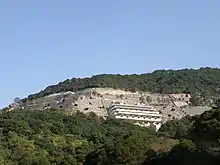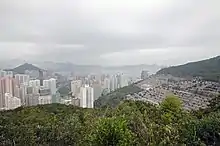
Cape Collinson Chinese Permanent Cemetery.

View of Chai Wan and Cape Collinson Chinese Permanent Cemetery.

View of Cape Collinson Chinese Permanent Cemetery on the mountain slope.
Cape Collinson Chinese Permanent Cemetery (Chinese: 柴灣華人永遠墳場; lit. 'Chai Wan Chinese Permanent Cemetery') is a private, non-profit cemetery in Cape Collinson, Hong Kong.[1] It is one of the largest cemeteries in Hong Kong.
The term 'Permanent' refers to the cemetery site, not the graves.[2] The cemetery is nevertheless like all other plots of land in the territory subject to a land lease. For this cemetery the lease expire in 2036.[3]
History
Cape Collinson Chinese Permanent Cemetery was opened in 1963 by The Board of Management of the Chinese Permanent Cemeteries,[4][5][6] a statutory body of Hong Kong established in 1913, that manages four Chinese permanent cemeteries in the territory.[7] The cemetery was extended in 1973.[2][8][9][10][11]
Notable burials
- Chung Chi-yung, educator, co-founder and principal of the Shue Yan College/Shue Yan University, former judge[12]
- Choi Park Lai, almanacist[13][14][15]
- Lam Sheung Yee, international footballer, educator and football commentator
- Shum Wai Yau, journalist, founder of Wah Kiu Yat Po
See also
References
- ↑ Chan, Arthur (5 September 2014). "Councillors reject cemetery traffic suggestions as 'impractical'". South China Morning Post. Retrieved 27 April 2020.
- 1 2 Teather, Elizabeth Kenworthy (March 1998). "Themes from Complex Landscapes: Chinese Cemeteries and Columbaria in Urban Hong Kong". Australian Geographical Studies. 36 (1): 25. doi:10.1111/1467-8470.00037. ISSN 0004-9190.
- ↑ "認購骨灰龕位條款及須知" (PDF) (in Chinese). The Board of Management of the Chinese Permanent Cemeteries.
- ↑ Dickhardt, Michael; Lauser, Andrea (2016). Religion, Place and Modernity: Spatial Articulations in Southeast Asia and East Asia. Brill. p. 317. ISBN 9789004320239.
- ↑ Hong Kong Chronicles Institute (2022). Hong Kong Chronicles: Overview & Chronology. Chung Hwa Book Co. (H.K.) Ltd. p. 323. ISBN 9789888807321.
- ↑ "華人永遠墳場管理委員會–關於華永會–墳場典故–柴灣華人永遠墳場". www.bmcpc.org.hk (in Traditional Chinese). Board of Management of the Chinese Permanent Cemeteries. Retrieved 27 April 2020.
- ↑ "HKU Centre on Behavioural Health releases survey findings on Hong Kong people's changing attitude towards death". The University of Hong Kong. 27 April 2015.
- ↑ "復修百年墳場文獻 連結香港舊時空". Ming Pao (in Chinese). 10 December 2021.
- ↑ "復修百年墳場文獻 連結香港舊時空". Ming Pao (in Chinese). 10 December 2021.
- ↑ "華永會復修百年葬冊 從墓地配售簿看日治歷史 鹿島通是何處". HK01 (in Chinese).
- ↑ "華永會復修百年葬冊" (PDF). The Board of Management of the Chinese Permanent Cemeteries.
- ↑ "鍾期榮遺體安葬柴灣華人永遠墳場". news.now.com (in Chinese). 26 March 2014.
- ↑ "蔡伯勵暫葬柴灣華人永遠墳場". Oriental Daily News (in Chinese). 1 August 2018.
- ↑ https://www.youtube.com/watch?v=FGCW93fbj4g
- ↑ "蔡伯勵今出殯 長眠柴灣華人永遠墳場". Yahoo! News (in Chinese). 31 July 2018.
Further reading
- Murray, Sarah (2011). Making an Exit: From the Magnificent to the Macabre – How We Dignify the Dead. St. Martin's Publishing Group. pp. 142–144. ISBN 9781429989299.
External links
Wikimedia Commons has media related to Cape Collinson Chinese Permanent Cemetery.
This article is issued from Wikipedia. The text is licensed under Creative Commons - Attribution - Sharealike. Additional terms may apply for the media files.